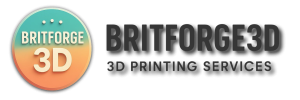Advanced 3D Printing Design Tips

Tutorials
Advanced 3D Printing Design Tips
Take Your Prints to the Next Level
Once you’ve mastered basic 3D printing, the next step is learning how to design models that print better, stronger, and more efficiently. In this guide from BritForge 3D, we’ll cover advanced design tips to help you get the most out of your 3D prints — whether you’re an engineer, maker, or product designer.
One of the most important advanced design concepts is understanding overhangs. 3D printers can usually handle overhangs up to 45 degrees without supports. By adjusting your model to keep angles under this limit, you can reduce the need for supports, save material, and improve surface finish.
Next, consider fillets and chamfers on edges. Sharp corners are more prone to cracking or warping due to stress concentration. Adding small fillets (rounded corners) not only makes your part stronger but also improves layer adhesion and printability. Chamfers can also help with ease of assembly or aesthetics.
Wall thickness is another critical factor. Thin walls (under 0.8 mm) may not print reliably, while excessively thick walls waste material and increase print time. For most functional parts, aim for walls at least 1.2–2 mm thick. This provides good strength without unnecessary weight or cost.
Adding ribs or gussets can dramatically increase the strength of flat parts without increasing thickness everywhere. Think of how aircraft wings use ribs to maintain lightness and strength. Similarly, adding strategically placed supports inside your design can reinforce large, flat sections.
Embossed or engraved features add detail, but should follow some minimum size rules for FDM printing: text should be at least 2–3 mm high with a line width of 0.4 mm or more. For SLA/resin printing, finer details are possible, but design for your specific printer’s resolution.
Clearances and tolerances are essential for parts that need to fit together. For FDM, plan 0.2–0.5 mm of extra space between mating parts to allow for printer variances. Resin prints may need slightly larger gaps due to resin shrinkage and over-curing during the printing process.
Another advanced strategy is using variable layer heights in your slicer. Thicker layers in less detailed parts and thinner layers in areas with fine details can save time while maintaining excellent surface finish where it matters most.
Consider print orientation during the design phase. Design your part so it can be printed with the largest flat area on the bed, reducing supports and warping risk. Parts designed for printing upright may have fewer surface imperfections and better dimensional accuracy.
Designing with infill patterns in mind can also improve performance. For example, honeycomb or gyroid patterns distribute forces more evenly. By designing your model’s internal features to complement these patterns, you can create parts that are both light and strong.
Finally, remember that every printer and material behaves differently. Prototype your design in inexpensive PLA before moving to more demanding materials like PETG or nylon. At BritForge 3D, we’re happy to print test pieces, suggest improvements, and help you get perfect results with advanced prints.
Conclusion
Advanced 3D printing design isn’t just about creativity — it’s about engineering your models to print reliably, efficiently, and with the desired performance. By applying these tips, you can reduce failures, save time, and make professional-quality parts. Need help with your next design? Contact BritForge 3D today for expert advice and high-quality printing services.
